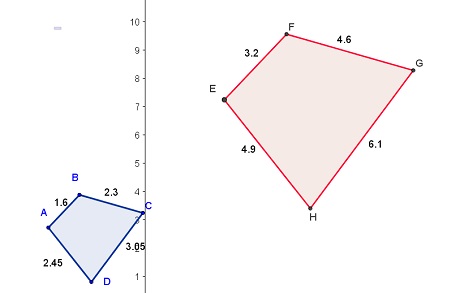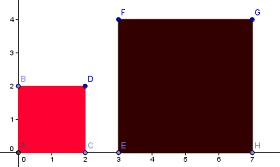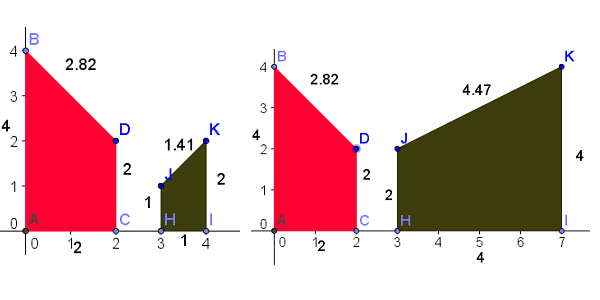To totally unlock this section you need to Log-in
Login
Have you ever wondered how machinists, carpenters and other skilled tradespeople can create full-scale objects from tiny blueprints? Or wondered how close a model ship or airplane looks to the real thing? Knowing about the scale factor can help you to better understand these topics.
Before you begin this lesson, you will want to recall two math terms: similar figures and ratio. Two geometric figures are similar if their corresponding angles are equal and their corresponding sides are proportional. A ratio is a fraction which compares two quantities. This picture shows two similar 4-sided figures:
In this picture, the blue figure is similar to the red figure. Each side in the red figure is twice the size of the corresponding side in the blue figure.
In two similar geometric figures, the ratio of their corresponding sides is called the scale factor. To find the scale factor, locate two corresponding sides, one on each figure. Write the ratio of one length to the other to find the scale factor from one figure to the other. In this example, the scale factor from the blue figure to the red figure is 1.6:3.2, or 1:2.
This means that for one unit of length on the blue figure, there are two units of length on the red figure. The scale factor from the red figure to the blue figure is 3.2:1.6, or 2:1.
It is important to notice two things about the scale factor:
The scale factor from the first figure to the second is always the reciprocal of the scale factor from the second figure to the first.
If you begin with the smaller figure, your scale factor will be less than one. If you begin with the larger figure, your scale factor will be greater than one. Ask yourself, 'Am I comparing a larger figure to a smaller figure, or a smaller figure to a larger?' This can help you check your work.
Using the Scale Factor
If two figures are similar, then you can relate different characteristics of the figure by using the scale factor. As an example, think of two squares that are similar. One has a side length of 2 inches and another has a side length of 4 inches. This gives a scale factor of 1:2 from the small square to the large square.
To obtain the side length of one square given the side length of the other, you can multiply or divide by the scale factor. Let's see this with the squares shown above.
Suppose you are told that the smaller square has a side length of 2 inches and the scale factor from the smaller to the larger is 1:2. Remember, this means that 1 inch on the smaller square is 2 inches on the larger square. If we multiply by the scale factor, 1/2, we will get a smaller number. So we must 'divide' by the scale factor to get a larger number.
We can see that this result matches the picture.
To obtain the perimeter of one square given the perimeter of the other, you can multiply or divide by the scale factor. The smaller square has a perimeter of 8 inches. We want to find the perimeter of the larger square. We will once again need to divide by the scale factor of 1:2.
The larger square will have a perimeter of 16 inches. Does this make sense? Ask yourself, 'Am I going from a smaller figure to a larger figure, or a larger figure to a smaller?' In this case, we went from a smaller figure to a larger figure, so we'd expect our answer to be larger than the original perimeter. Therefore, our answer makes sense!
To obtain the area of one square given the area of the other, you can multiply or divide by the square of the scale factor. In our example, the smaller square has an area of 4 square inches. Just as we divided by the scale factor to determine the perimeter of the larger square, we will now divide by the square of the scale factor.
To obtain the volume of one cube given the volume of the other, you can multiply or divide by the cube of the scale factor. To decide if you should multiply or divide, you should consider the value of the scale factor and if you are going from a larger to a smaller figure, or a smaller to a larger.
Imagine that instead of squares, we have two cubes, like large dice. The smaller cube has a side length of 2 inches, and the other has a side length of 6 inches. The volume of the first cube is 8 cubic inches, and the scale factor from the larger cube to the smaller is 3:1. To find the volume of the larger cube, we can multiply by the cube of the scale factor (notice how our scale factor is larger than one; we know we want a larger answer, and so we multiply rather than divide).
The volume of the second cube is therefore 216 cubic inches. Checking our work, we can see that:
We can use these examples of finding side length, perimeter, area, and volume for any pair of similar figures. It makes knowing the scale factor incredibly useful.
Example Problems from Math Class
You can show that two figures are similar by finding the scale factor for each pair of corresponding sides. In the picture, the red and black figures on the left hand side are similar, while the figures on the right are not.
We can write ratios of the corresponding sides - notice that the figures are facing opposite ways, so we have to be careful to match the shortest side to the shortest side, the longest side to the longest side, and so forth. Starting with the diagonal side of each figure, we have:
All of these ratios are equal, so the figures are similar. In the second pair of figures, we obtain the following ratios, going from red to black:
It is easy to see that these ratios are not equal. Therefore, the figures are not similar.






